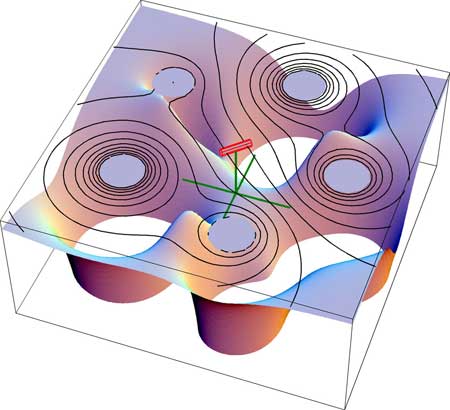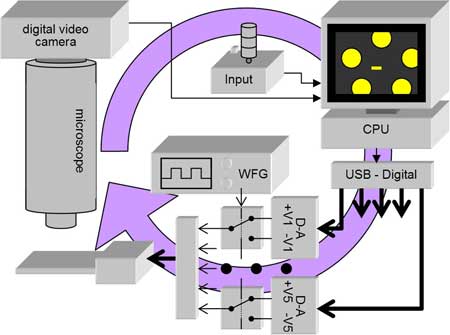| Posted: August 18, 2006 |
Electric tweezers - now everyone can have a desktop lab |
|
(Nanowerk News) The ability to sort cells or manipulate microscopic particles could soon be in the hands of small laboratories, high schools and amateur scientists, thanks to researchers at the University of Pennsylvania School of Engineering and Applied Science. They have created a device, called "electric tweezers," which can manipulate and move almost any object seen on a simple microscope slide.
|
|
The research was led by graduate student Brian Edwards, with the help of his advisor Nader Engheta, professor, and Stephane Evoy, adjunct assistant professor, both of Penn's Electrical and Systems Engineering Department. While devices with similar functionality using lasers exist, they often cost upwards of a quarter-million dollars. Edwards' device performs some of the same tasks as laser tweezers, yet at a price anticipated to be in the same range as a high-end desktop computer.
|
|
"The tweezers create an electric field that you can use to manipulate almost any object on a microscopic scale. It has the potential of being a powerful tool for research," said Edwards, a doctoral candidate in Penn's Electrical and Systems Engineering Department. "I would prefer not to put a limit on the type of tasks that can be done with it, but I hope it will find uses in anything from picking an individual cell out of a culture to fabricating circuits."
|
 |
|
A small rod surfs the crests of the magnetic field generated by the five electrodes (dark circles). (Image: University of Pennsylvania)
|
|
All it would take to use electric tweezers is a computer and a microscope. The tweezers' action occurs on a common glass microscope slide embedded with five electrodes. These electrodes create an electric field that can be used to push, pull, move and spin a selected object in any direction without actual physical contact. Using software Edwards developed, an operator can select an individual object from a microscope image on a computer screen.
|
|
"Different types of particles respond differently to different frequencies in the electric field," Edwards said. "Once you lock onto the object of interest you can move it however you like."
|
|
The electric tweezers take advantage of the phenomenon known as dielectrophoresis, where electric fields impart a force upon a neutral particle. In essence, the object that is selected surfs atop the hills and valleys created by subtly changing the electric field. The principle works best on the microscopic scale, which makes it ideal for this application.
|
|
"Moving objects with the tweezers is a lot like playing one of those wooden labyrinth games, but, instead of twisting knobs to move a ball in the maze, we're adjusting an electric field to move a small object," Edwards said. "The tweezers move the object by fiddling with the electric field. All the math is done on the computer, so all the user needs to do is move a joystick."
|
 |
|
A schematic of the electronic tweezer setup. (Image: University of Pennsylvania)
|
|
According to Edwards, the electrical field can be attuned to almost anything visible through a microscope. He believes the device will be a boon to smaller laboratories that cannot afford similar devices, as well as to high schools and science hobbyists. Its size, utility and potentially low price could put it into the hands of almost anyone interested in experimenting with the technology.
|
|
"We hope that the electric tweezers could mean to science what the PC meant to computing; it's a scientific tool for the rest of us," said Hugo FitzGerald nanotechnology and licensing manager at Penn's Center for Technology Transfer.
|
|
The Center is assisting Edwards in patenting and, along with the Bressler Group, bringing electric tweezers to the marketplace.
|
|
Scientists at the Max Planck Institute for Biophysical Chemistry in G?ttingen have now achieved a resolution of up to 15nm with their STED microscope (Stimulated Emission Depletion). Their fluorescence microscope is thereby twelve times sharper than a conventional one. Already in April, the team of scientists lead by Professor Stefan Hell achieved a detail sharpness of up to 60 nanometers in cells.
|


